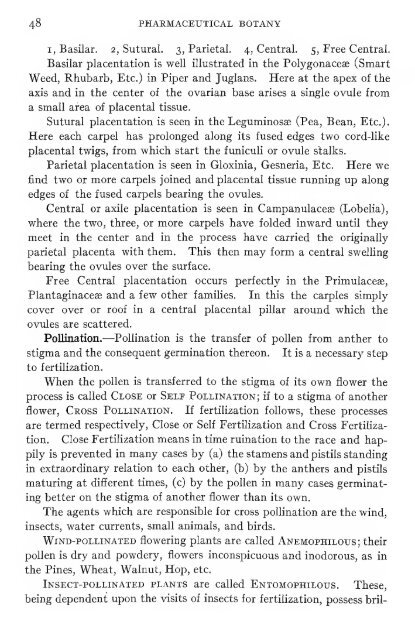Pharmaceutical botany - Lighthouse Survival Blog
Pharmaceutical botany - Lighthouse Survival Blog
Pharmaceutical botany - Lighthouse Survival Blog
You also want an ePaper? Increase the reach of your titles
YUMPU automatically turns print PDFs into web optimized ePapers that Google loves.
48<br />
PHARMACEUTICAL BOTANY<br />
I, Basilar. 2, Sutural. 3, Parietal. 4, Central. 5, Free Central.<br />
Basilar placentation is well illustrated in the Polygonacece (Smart<br />
Weed, Rhubarb, Etc.) in Piper and Juglans. Here at the apex of the<br />
axis and in the center of the ovarian base arises a single ovule from<br />
a small area of placental tissue.<br />
Sutural placentation is seen in the Leguminosae (Pea, Bean, Etc.).<br />
Here each carpel has prolonged along its fused edges two cord-like<br />
placental twigs, from which start the funiculi or ovule stalks.<br />
Parietal placentation is seen in Gloxinia, Gesneria, Etc. Here we<br />
find two or more carpels joined and placental tissue running up along<br />
edges of the fused carpels bearing the ovules.<br />
Central or axile placentation is seen in Campanulacese (Lobelia),<br />
where the two, three, or more carpels have folded inward until they<br />
meet in the center and in the process have carried the originally<br />
parietal placenta with them. This then may form a central swelling<br />
bearing the ovules over the surface.<br />
Free Central placentation occurs perfectly in the Primulacese,<br />
Plantaginaceffi and a few other families. In this the carples simply<br />
cover over or roof in a central placental pillar around which the<br />
ovules are scattered.<br />
Pollination.—Pollination is the transfer of pollen from anther to<br />
stigma and the consequent germination thereon. It is a necessary step<br />
to fertilization.<br />
When the pollen is transferred to the stigma of its own flower the<br />
process is called Close or Self Pollination; if to a stigma of another<br />
flower, Cross Pollination. If fertilization follows, these processes<br />
are termed respectively. Close or Self Fertilization and Cross Fertiliza-<br />
tion. Close Fertilization means in time ruination to the race and hap-<br />
pily is prevented in many cases by (a) the stamens and pistils standing<br />
in extraordinary relation to each other, (b) by the anthers and pistils<br />
maturing at different times, (c) by the pollen in many cases germinat-<br />
ing better on the stigma of another flower than its own.<br />
The agents which are responsible for cross pollination are the wind,<br />
insects, water currents, small animals, and birds.<br />
Wind-pollinated flowering plants are called Anemophilous ; their<br />
pollen is dry and powdery, flowers inconspicuous and inodorous, as in<br />
the Pines, Wheat, Walnut, Hop, etc.<br />
Insect-pollinated plants are called Entomophilous. These,<br />
being dependent upon the visits of insects for fertilization, possess bril-
















